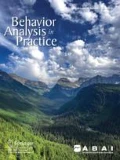Abstract
The development and the evolution of the Virginia Applied Behavior Analysis Consortium, a collaborative project between four institutions of higher education in the state of Virginia, are described. The main goal of the program is to address the shortage of certified behavior analysts by preparing special education teachers and autism specialists to implement effective behavior-analytic interventions in natural environments. In this article, we briefly discuss the history and the purpose of the program, its components, the evolution of the program, the advantages and outcomes of a collaborative model, and future directions for improvement.


References
Behavior Analyst Certification Board (n.d.). Retrieved from http://bacb.com
Behavior Analyst Certification Board (2012). Retrieved from: https://info.bacb.com/o.php?page=100155
Behavior Analyst Certification Board (2016). Retrieved from: https://info.bacb.com/o.php?page=100155
Bordieri, M. J., Kellum, K. K., & Wilson, K. G. (2012). Editorials: special issue on behavior analysis and education—introduction. The Behavior Analyst Today, 13, 1–2.
Catania, A. C., DeLeon, I. G., & Cataldo, M. F. (2000). A master’s program in applied behavior analysis: contingencies for initiation and maintenance. The Behavior Analyst Today, 1, 58–63.
Glenn, S. S., & Ala’I-Rosales, S. (2001). University of North Texas: master of science in behavior analysis. The Behavior Analyst Today, 2, 253–258.
Granpeesheh, D., Tarbox, J., Dixon, D. R., Peters, C. A., Thompson, K., & Kenzer, A. (2010). Evaluation of an eLearning tool for training behavioral therapists in academic knowledge of applied behavior analysis. Research in Autism Spectrum Disorders, 4, 11–17. doi:10.1016/j.rasd.2009.07.004.
Hawkins, R. P., Chase, P. N., & Scotti, J. R. (1993). Applied behavior analysis at West Virginia University: a brief history. Journal of Applied Behavior Analysis, 26, 573–582.
Horner, R. F., Carr, E. G., Halle, J., McGee, G., & Wolery, M. (2005). The use of single-subject research to identify evidence-based practice in special education. Exceptional Children, 71, 165–179.
Johnston, J. M. (2016). Necessity and opportunity: the 1-year master’s ABA program at Auburn University. Behavior Analyst, 39, 135–142. doi:10.1007/s40614-016-0057-6.
LeBlanc, L. A., Heinicke, M. R., & Baker, J. C. (2012). Expanding the consumer base for behavioranalytic services: meeting the needs of consumers in the 21st century. Behavior Analysis in Practice, 5, 4–14.
Martinez-Diaz, J. A., & Wilder, D. A. (2016). Conceptualization and development of the behavior analysis program at the Florida Institute of Technology. Behavior Analyst, 39, 149–156. doi:10.1007/s40614-016-0060-y.
Normand, M. P., & Kohn, C. S. (2013). Don’t wag the dog: extending the reach of applied behavior analysis. The Behavior Analyst, 36, 109–122.
Shook, G. L., Ala’I-Rosales, S., & Glenn, S. S. (2002). Training and certifying behavior analysts. Behavior Modification, 26, 27–48.
Shook, G. L., Johnston, J. M., & Mellichamp, F. H. (2004). Determining essential content for applied behavior analyst practitioners. The Behavior Analyst, 27, 67–94.
Virginia Department of Education (2009). Report of the joint legislative audit and review commission to the governor and the assembly general of Virginia (house document no. 8). Retrieved from http://jlarc.virginia.gov/pdfs/reports/Rpt388.pdf
Warkomski, F. (1999). Applied behavior analysis credential program in Pennsylvania and beyond. Behavior Analyst Today, 1, 18–20.
Weiss, M. J., & Shook, G. L. (2010). Resources on training requirements for applied behavior analysts: the Behavior Analyst Certification Board and the autism special interest group consumer guidelines. European Journal of Behavior Analysis, 11, 217–222.
Williams, B. F., McLaughlin, T. F., Williams, R. L., & Howard, V. F. (1991). Student research, its place in behavior analysis: personnel preparation in a department of special education. Child and Family Therapy, 13, 73–77.
Zangrillo, A. N., Warzaki, W. J., Volkert, V. M., Valleley, R. J., Shiver, M. D., Rodriquez, N. M., & Allen, K. D. (2016). The Munroe-Meyer approach: continuous integration of didactic instruction, research, and clinical practice. The Behavior Analyst, 39, 157–166. doi:10.1007/s40614-016-0062-9.
Acknowledgments
We thank the administrators, faculty members, and staff at all four universities for their continuous support and contribution to the founding, organization, and progress of the program.
Author information
Authors and Affiliations
Corresponding author
Ethics declarations
Funding
The program described in this manuscript was funded by the Virginia Department of Education (grant number 203658).
Rights and permissions
About this article
Cite this article
Chezan, L.C., Layden, S.J., Barnhill, G.P. et al. The Virginia Applied Behavior Analysis Consortium: Preparing Behavior Analysts Using a Collaborative Model. Behav Analysis Practice 11, 214–227 (2018). https://doi.org/10.1007/s40617-017-0195-7
Published:
Issue Date:
DOI: https://doi.org/10.1007/s40617-017-0195-7

